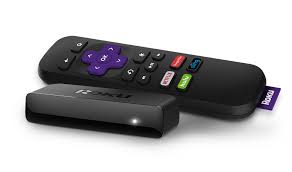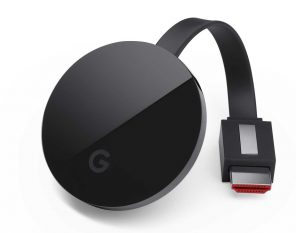
If you’re shopping for a streaming TV device, you know you have choices. There are three major options when it comes to selecting a TV streamer: they are Google, Roku, and Apple.
If you’re thinking about getting into streaming TV, upgrading your existing streaming system, advancing to 4K technology, or perhaps just shopping for a gift for someone else, here’s what you need to know about each of the devices and how to choose between them.
Apple TV
Apple TV is probably the granddaddy of them all when it comes to streaming devices. It’s been around the longest, has the largest library of content, and is super easy to use making it popular with streaming fans. It has a simple to use home screen and user interface that allows customers to easily navigate among Apple’s own content or to surf other services like YouTube and Netflix.
Apple’s remote has voice search, gesture control
While earlier versions of AppleTV (3rd generation) do come with a small and basic silver remote control, newer versions (4th generation) come with an upgraded remote featuring a touchpad, voice search and gesture controls (it also doubles as a game controller). This allows you to speak to Apple assistant Siri and tell her the shows you’re looking for. She will search across all channels, platforms, apps, and services to find whatever you’re looking for so there’s no hunting individual channels. You can also use your iPhone as a remote control for Apple TV devices, giving it lots of versatility.
Apple TV is HD-only. For now…
Apple TV is available for full HD viewing, and comes with Dolby Digital 7.1 surround sound, but as of yet does not have 4K or Ultra High Definition support.
Apple TV connects via an HDMI cable to your TV. Like all streamers, it connects with HDMI though it does offer an ethernet connection also. It is among the largest of the HD streaming devices out there, so for some people it might be harder to hide it behind a wall-mounted TV.
While Apple may have been first on the market, it was late to the party in terms of high definition or 4K streaming. Competitors Google and Roku both have 4K devices available now so if you’re looking to upgrade to ultra high resolution, you’ll have to bid Apple goodbye… or get a second option.
If you look at Apple TV in terms of its pros and cons, Apple still has the largest content library out there. But it hasn’t kept pace with ultra high definition technology yet. If you’re looking for a simple streaming device with the most content, the 4th generation Apple TV version should get the job done for you. You’ll also love it if you’re already integrated into the Apple ecosystem. If you are imminently upgrading to 4K, you’ll need to shop elsewhere.
Roku TV
Roku has been going like gangbusters and this fall brought out a suite of five new devices to solve all of your streaming TV problems. While you can click here to read about all the new streamers that are available and what each one can do, the Coles Notes version goes like this:
Which of the new Roku devices is for me?
For basic HDTV use, Roku Express or Express + is what you’ll want. If you have an older television set with no HDMI port, you can still get in the streaming game: the Roku Express+ is the one for you (more on that in a second).
If you have a 4KTV or plan to get one soon, move up to Roku Premiere which is made for 4K viewing. If you want an even better picture (4K plus HDR colour support) along with private listening with your headphones, upgrade to Roku Premier+.
If you want all the bells and whistles — 4K, HDR, private listening and voice search, plus a faster processor, you’ll want Roku Ultra. The size of the devices ranges from chocolate bar to sandwich.
No HDMI port? Roku to the rescue!
In almost every case a streaming TV device requires an HDMI port. But when Roku announced its latest new products, it brought out a device that connects via optical or composite cables — the Roku Express +. That means you can connect it to almost any older TV, and still enjoy streaming content. Depending on the vintage of your old set, the quality may not look great, but it could be the perfect answer for a spare room, kids play area or just to keep some electronic junk out of a landfill.
As a bonus, both those composite and HDMI cables are included in the box, so you can easily swap it from older to newer TVs.
Roku is easy to use and user-friendly
As I’ve written about numerous times, Roku’s streaming TV platform is extremely easy to use and very user-friendly. All Roku devices also come with an included remote control. While some may find that a bit redundant, since you can also control Roku with your cell phone, I find it handy being able to pick up the remote control to play, pause or skip ahead without having to navigate through my phone apps (and distracting texts and emails) to do that.
Also, it’s worth mentioning several of the Roku remotes also come with enhancements as noted above, such as headphones for private listening, as well as voice search, making it very competitive with Apple. While Apple and Google may get all the press, Roku is this year’s unsung hero of TV streaming as far as I’m concerned.
Google Chromecast
 The Google Chromecast device has been the go-to TV streaming device for Android users since its launch a couple of years ago. Fortunately, it’s also a good option for Apple users as well, though it does have limitations on that platform.
The Google Chromecast device has been the go-to TV streaming device for Android users since its launch a couple of years ago. Fortunately, it’s also a good option for Apple users as well, though it does have limitations on that platform.
Google Chromecast, and now Google Chromecast Ultra are small circular shaped dongles which connect to your TV’s HDMI port and stay easily hidden from view. Only about the diameter of a lime, and as thick as your pinky finger, the device can slip into the smallest spaces making it an excellent choice for wall-mounted televisions.
Like its streaming cousins, Google Chromecast and Chromecast Ultra also has access to Netflix, YouTube, and dozens of other streaming TV channels, plus the offerings of the Google Play store.
Google Chromecast and Google Chromecast Ultra — What’s the difference?
Google Chromecast is for HDTVs but has a fast processor and connects with Wi-Fi. Chromecast Ultra has an even faster processor, adds ethernet connectivity to the Wi-Fi option and has support for 4K or Ultra High Definition viewing.
Google Chromecast operates differently
Google Chromecast some pretty significant differences from the previous two devices. For one, it only uses your cell phone for control. For another; it operates in a bit of a different way. Chromecast, instead of presenting you with a menu of options on your TV screen, instead uses the apps on your smartphone to interact. You must first choose which app you want to use, and download or access the app. Then you load it up on your cell phone and “cast” the content to your TV.
I find this a rather clunky way to interact with the system, and much prefer having everything at my fingertips on a main screen. Since you can’t do that here, it’s helpful if you can keep all of your casting apps in a special folder or place on your smartphone in order to minimize hunting.
Three great choices: Roku, Apple, Google
Each of the streaming devices has its own benefits and minuses. Overall, I find it helpful to stay with the same operating system that you use for your smart phone or other devices in your home.
I think each of these top three streaming devices works amazingly well. I own one of each device myself, and use them in different ways, in different rooms, and with different platforms. Yes, I’m a tech blogger who is probably going overboard, but that’s just to say that I find each device well worth the purchase. As I said, you’ll probably want to distill your buying decision down to which operating system you use most in your home. Or go ahead and get two devices… or three. I certainly won’t judge you.
What’s YOUR favourite streaming device, and why? Tell us about it in comments, below.




The ROKU is my streamer of choice having had one for 5 years now and it has worked flawlessly. It gives you many programing choices and more are added regularly. Lots of gaming and apps for those so inclined. Definitely a good purchase as it has paid for itself many times over.
I agree that Roku and AppleTV are more versatile, especially since they also incorporate an Ethernet connection and are not reliant on Wi-Fi, also because they have a dedicated remote control in addition to a smart device application that needs to be installed, for full integration to IOT.
It sounds like the Roku is more versatile for media streaming, however Apple TV has access to apps and gaming.
Tough choices ahead, thank you Erin!
Comments are closed.